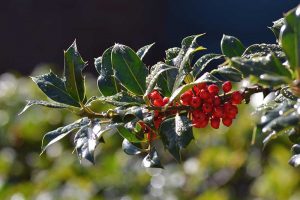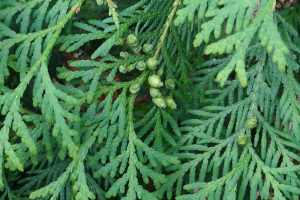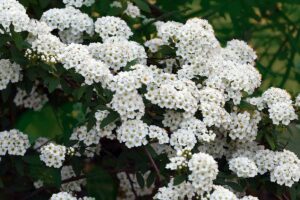You gotta love how birchleaf spirea, Spiraea betulifolia, grows as a perennial in the USDA Hardiness Zones that may experience -40°F temperatures in the winter.
And the way that it produces copious clusters of blooms all spring, attractive green or yellow leaves in summer, and a kaleidoscope of colorful foliage in autumn is also sure to be admired.
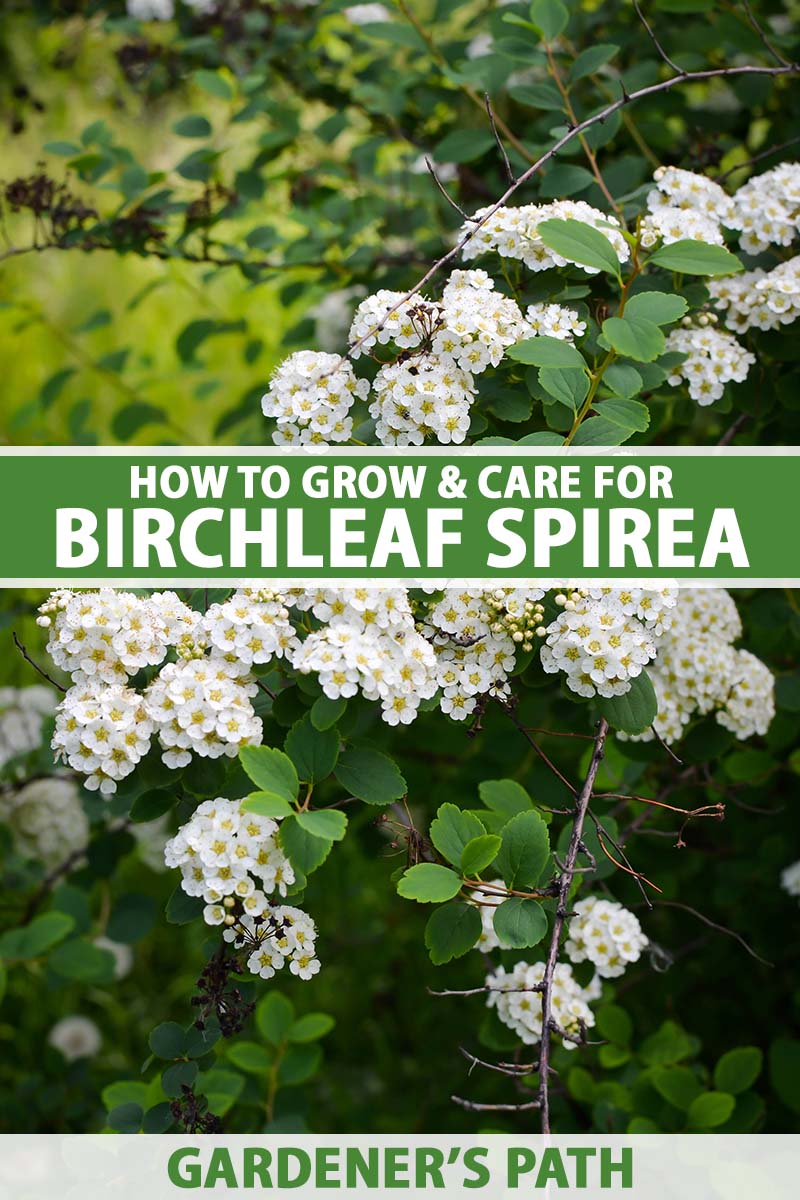
We link to vendors to help you find relevant products. If you buy from one of our links, we may earn a commission.
Speaking of positive reactions, bees love birchleaf spirea’s nectar-rich blooms, and you may spy hummingbirds sipping from the flowers too if you decide to grow this beneficial ornamental shrub in a border, bed, or container.
I present this growing guide to help you decide if this variety of spirea is a good fit for your landscape design and the limitations of your garden or the area where you grow ornamental plants.
With affection and good humor, I’ll cover these topics:
What You’ll Learn
What Is Birchleaf Spirea?
This mounding shrub is one of the 100 unique species within the Spiraea genus.
Listen up, gardeners in northern climates: This exceptionally hardy ornamental shrub offers three-season interest in USDA Hardiness Zones 3 to 9, depending on the cultivar.
Considered a dwarf spirea, it grows from about two to four feet tall, depending on the variety, and spreads about that wide with a mounding habit.
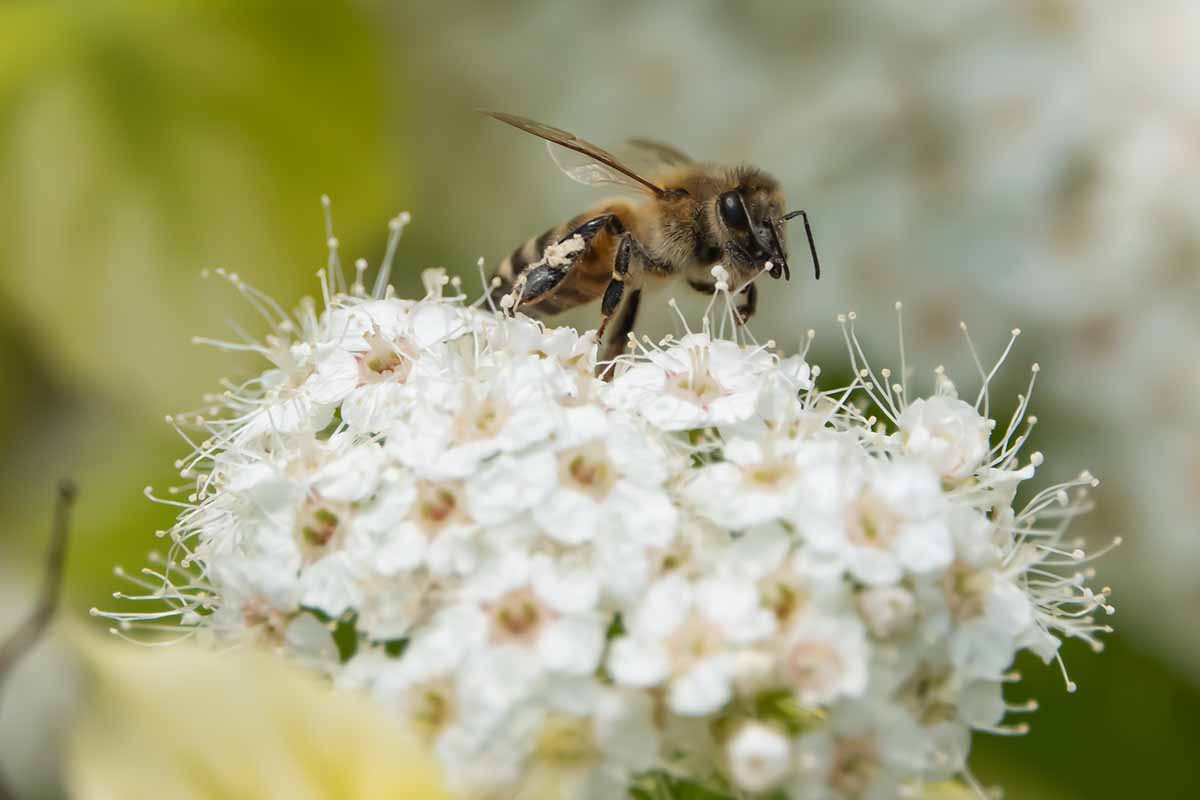
Clusters of white or pink flowers bloom throughout the spring, with beautiful leaves exhibited throughout the summer.
While other spirea species have oval-shaped leaves, S. betulifolia produces two-inch round or egg-shaped leaves that resemble birch foliage, hence the name.
These leaves are typically deep green, lime green, or yellow in spring and summer, depending on which birchleaf variety you’ve selected.
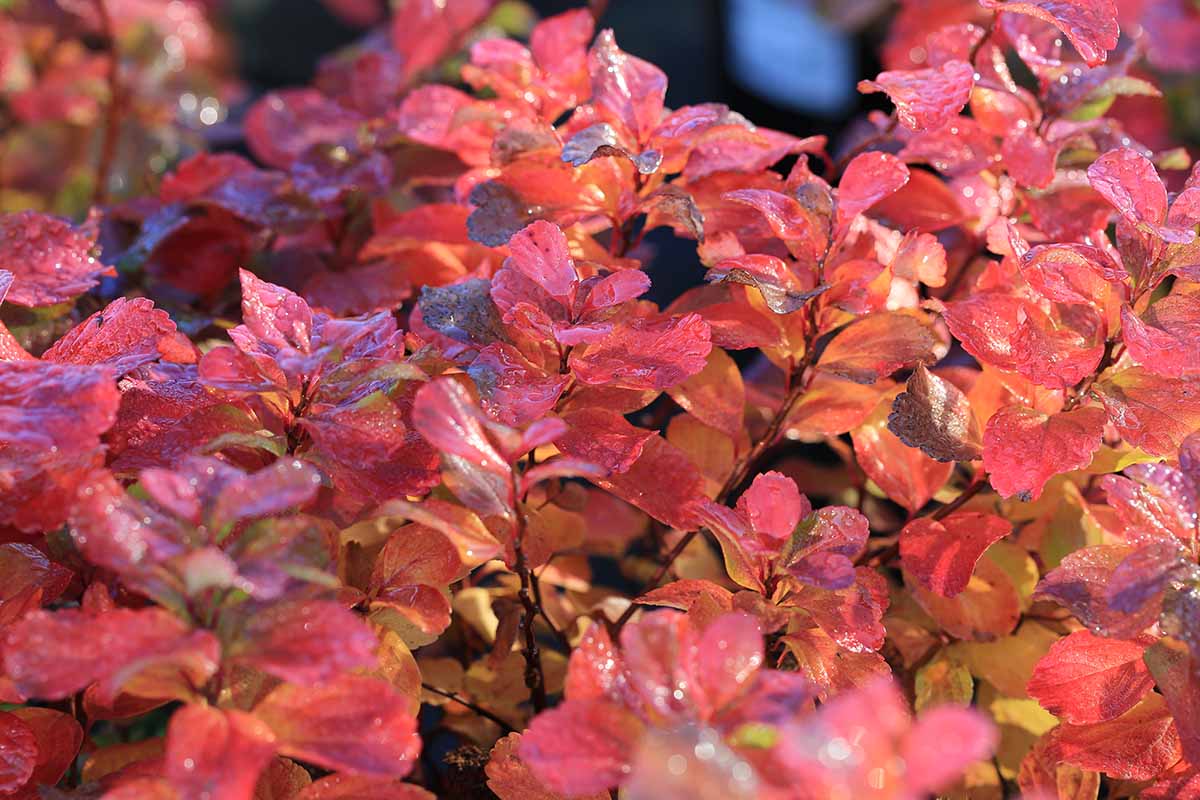
In fall, they take on a whole new look, sporting foliage in a kaleidoscope of colors ranging from red to chartreuse, burgundy to bronze, orange to lime green, and many in between combinations.
This species is native to Japan and other parts of East Asia. If you’ve seen it tagged as a native plant in the US, that’s only true of two varieties.
S. betulifolia var. corymbosa, also called shinyleaf meadowsweet, is native to the eastern US ranging from Alabama and Georgia north to Pennsylvania, while S. betulifolia var. lucida, or shinyleaf spirea, is native to western North America from Oregon, Wyoming, and Minnesota north to Saskatchewan and British Columbia.
But don’t fret if you aren’t growing one of those types in one of those areas. This is still a beneficial species for wildlife and the local environment.
It provides erosion control and nectar for pollinators, and is drought tolerant once plants are established. Birchleaf spirea also grows in poor soil and is easily propagated from cuttings, so it’s economical, too.
Whether you’re sold on the benefits or still deciding, let’s look at what’s required for the growth and care of this versatile, beautiful flowering shrub.
Birchleaf Spirea Propagation
Like the other Spiraea species popular with gardeners and landscapers, S. betulifolia can be propagated from softwood or hardwood cuttings.
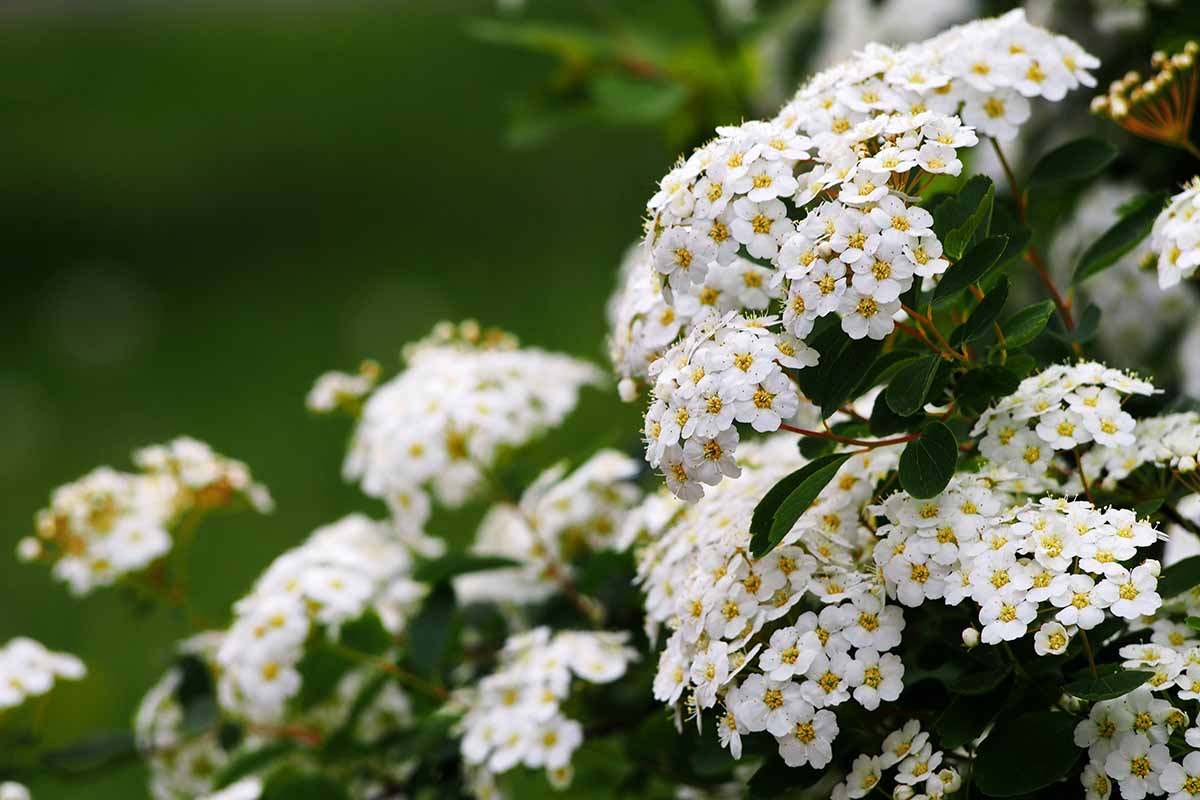
Or, you could start a new shrub via layering. To layer, you bend a long stem to the ground and weigh it down until it roots, then sever the new plant from the parent shrub.
You can find detailed instructions on all three spirea propagation methods in our guide.
If you purchase a shrub online or from a local nursery, you can transplant it into a container with double the diameter and depth of the root ball. Ensure it has drainage holes and that provide a well-draining potting mix.
To transplant into the ground, dig a hole in well-draining soil one and a half times as wide as the current container and twice as deep.
Ease the shrub into the hole so the root ball is even with the soil surface, and then backfill with more well-draining soil.
Water well. Apply a two-inch layer of mulch around the base to deter weeds and conserve water.
Learn more about using mulch for low-maintenance gardening in our guide.
Once the plants are in the ground, your work is mostly done. Coming up, I’ll go over growing strategies and maintenance chores, but they’re not extensive.
How to Grow Birchleaf Spirea
Getting birchleaf spirea off to a good start is fairly straightforward. It’s not at all picky.
While it prefers rich loam, with a pH of 6.0 to 7.0, it will grow in chalk, sand, or average loam as long as it’s well-draining. Add fine grit or landscaping sand as needed to promote drainage.
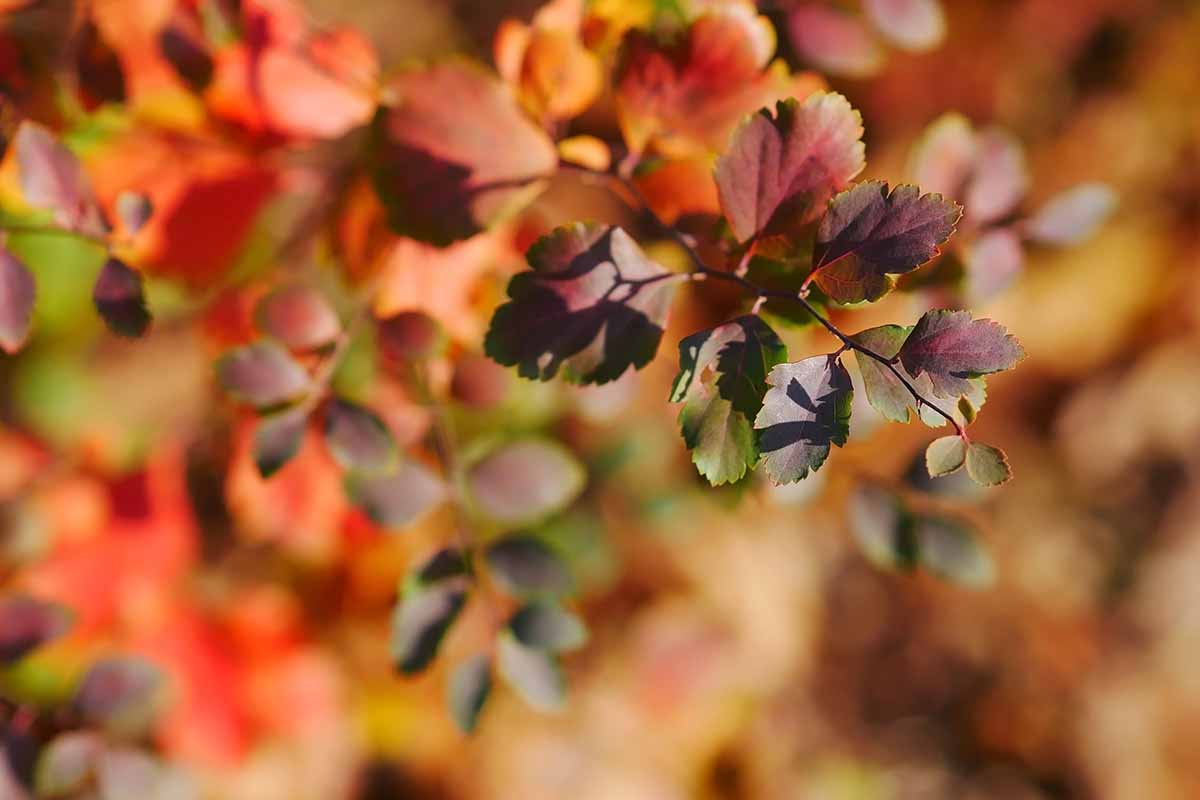
Ideally, you’ll also be able to provide a full sun spot for these sun-lovers, at least six hours per day. They’ll do okay in part sun, but they won’t bloom as much and the branches probably won’t get as full.
They appreciate supplemental water but gauge the need by checking how dry the soil is instead of watering on a schedule.
These shrubs prefer a deep drenching only once the soil is nearly dry, which you can determine with a soil moisture meter or by plunging your pinky finger a few inches down in the dirt.
Overwatering or allowing the shrubs to stand in pooled water can promote root rot.
It’s a good idea to fertilize birchleaf spirea in early spring, but only fertilize once a year. Use an all-purpose, slow-release shrub food to see spirea through the blooming and colorful foliage seasons.
Pick up some more tips for growing all types of spirea in our general guide.
Growing Tips
- To maximize blooming and promote plant health, grow in full sun if possible.
- Plant in well-draining soil.
- Apply all-purpose slow-release fertilizer just once a year, in early spring.
- Water thoroughly but only when the soil is dry to avoid the risk of deadly root rot.
Pruning and Maintenance
When you’ve planted S. betulifolia in a prominent spot where patio diners or front-door visitors will be looking right at it, you may want to deadhead the flowers.
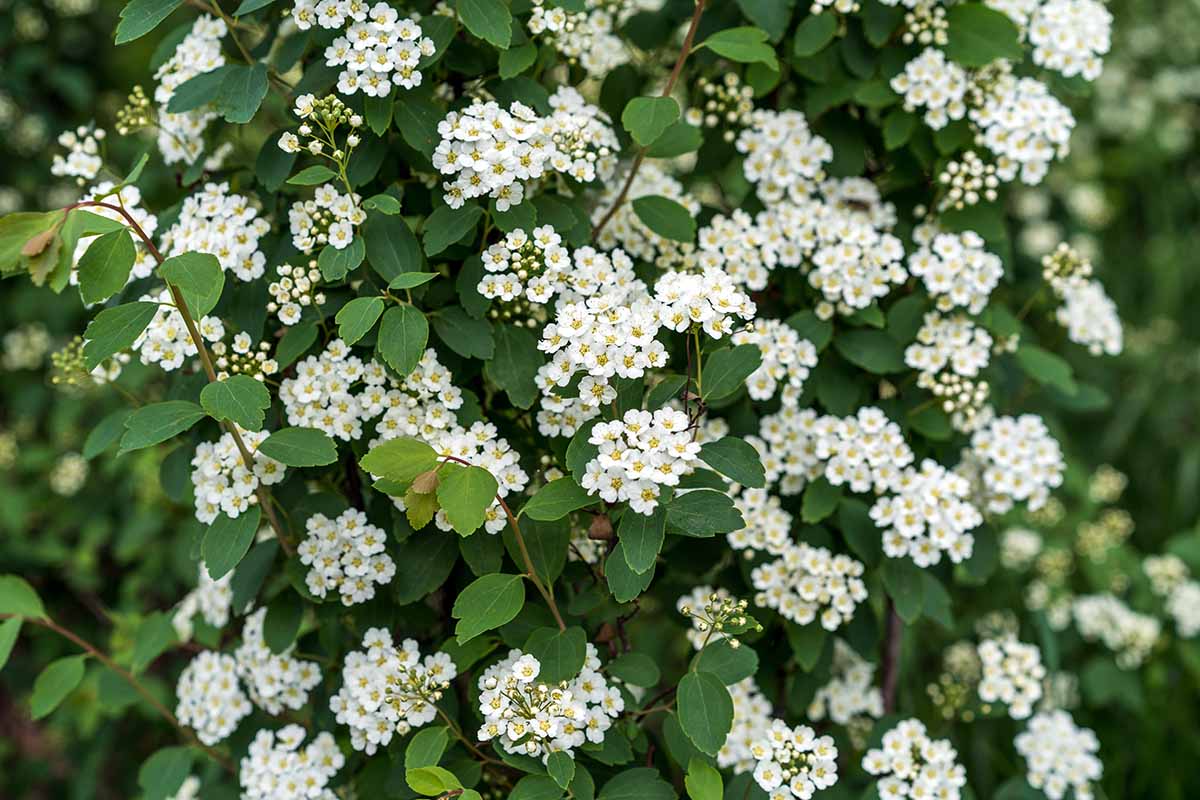
It can be a little time-consuming, but besides making these spring-blooming shrubs look more attractive, deadheading will promote a second round of blooms that could continue into early summer.
Pruning is also a good idea. It may seem counterintuitive, but you’ll want to prune in late winter or early spring, just as the stems are really getting going.
Clip the budding branches to within about four inches of the base. Yes, I do mean for you to clip all the stems. The buds at the bottom will leaf out and the shrub will come back stronger and fuller than ever.
Plants growing in containers will require another maintenance chore. Even though these shrubs will survive the winter months in Zones 3 to 9 or 4 to 8, depending on the cultivar, it’s not good for the potted plants to constantly freeze and thaw.
Once freezing weather sets in, prune the top half of the branches and move the pots to a protected location with strong light. A garage or shed with substantial light from a window is ideal.
As the weather begins to warm in spring, move the containers back outdoors, but only after spending a week getting them acclimated to increasing amounts of sunlight and different temperatures.
Find more info on caring for spirea shrubs in winter in our guide.
Birchleaf Spirea Cultivars to Select
Between the new cultivars with fresh autumn foliage colors and the old favorites with the more traditional bronze, red, or orange fall leaves, there are fun choices among the available S. betulifolia varieties.
Check these out:
Gold Tor
You glow, girl! Glow Girl® ‘Gold Tor’ is a Proven Winners selection from the Glow Girl series.
Even its flower buds look freshly made up in a pleasing palette, reddish before opening to reveal bright white blooms in spring.
‘Gold Tor’ is hardy in Zones 3 to 8. Its golden spring and summer foliage makes an attractive hedge that can grow three to four feet tall with a mature spread of three to five feet.
In fall, the foliage turns orangey-red to purple.

This birchleaf spirea cultivar has been bred to grow well in part shade with afternoon sun protection in warmer climates, or in full sun in northern locales.
Glow Girl® ‘Gold Tor’ is available in a two-gallon container from Green Promise Farms via Amazon.
Pink Sparkler
Long after the summer fireworks are finished, Pink Sparkler™ enlivens the fall landscape when its summertime green leaves change to a striking pink-burgundy for fall.
Of course, this shrub is sparkly in the spring, too, with large, round, pink flower heads that appear up and down the stems at the leaf axis. When it reblooms later in the season, expect tinier blossoms.
This cultivar grows three to four feet tall and spreads three or four feet wide. Bred in France, it is hardy in Zones 3 to 8.
If you’ve been looking for a flowering shrub to complement white or pink dogwood, here you go.
Pink Sparkler™ is available from Nature Hills Nursery.
Superstar
‘Superstar’ produces show-stopping pink-purple flower clusters all spring long.
When the blooms are finished, expect a full complement of dark green foliage through the summer, giving way to bronzed leaves in autumn.
Hardy in Zones 3 to 8, ‘Superstar’ is a natural choice for those who live in extra cold regions.
It grows about three feet tall and spreads four feet wide, making this cultivar a good choice for mass planting.
‘Superstar’ is available in one-gallon pots from EZ Growing Plants via Amazon.
Managing Pests and Disease
S. betulifolia has few issues with pests or diseases, which is part of its easy-care appeal.
I’m not saying rabbits or deer would never sneak a nibble of the leaves, especially at peak tenderness in early spring, but birchleaf spirea is not one of their preferred foods.
Despite the minimal threat, you should inspect your plants for pest infestation regularly, especially before moving container shrubs for the winter.
Find more info on preventing, detecting, and controlling the most common culprits in our aphid, scale, and spider mite guides.
Since S. betulifolia is a member of the Rosaceae or rose family, it’s not surprising that it may contract a few of the same diseases, though they’re fairly rare.
Fireblight, leaf spot, and powdery mildew could cause problems, so be on the lookout for those.
Root rot presents a more substantial threat.
I recommend paying close attention to preventive measures including judicious watering, spacing that allows air circulation, and providing well-draining soil.
Root rot is the most likely foe to kill your spirea outright, and that would be a shame when it’s so easily prevented.
Best Uses of Birchleaf Spirea
With birchleaf spirea delivering three-season interest with minimal care, it can beautify dozens of spots in the landscape.
Just a few of the places it stands out include garden beds, borders, walkways, and patio containers.
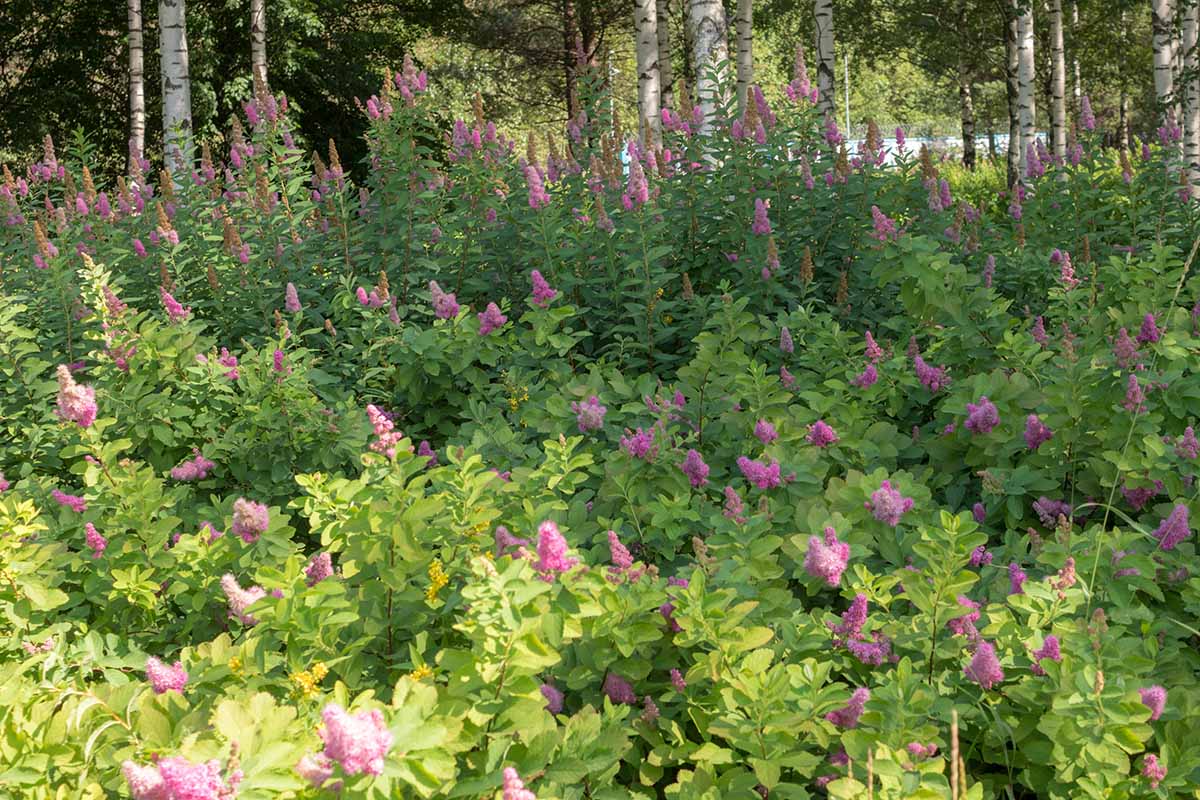
And it’s such a practical beauty, with the mounding shrubs offering erosion control, a short privacy hedge or windbreak, or an important nectar and pollen source for hummingbirds and pollinator gardens.
I caution you not to plant this lovely shrub in a high-profile front bed or walkway, though, unless you’re prepared to see a sizable dormant plant with no leaves throughout the winter.
Even the cultivars that are hardy in Zone 3, where temperatures may dip to -40°F, do not provide visual interest in the cold months.
If you want to plant it in a prominent spot, consider using a container so you can roll it out of the public eye throughout the months of dormancy.
Three seasons of appeal is a lot for any plant, so don’t push it by expecting good looks for a fourth season!
Quick Reference Growing Guide
| Plant Type: | Deciduous perennial flowering shrub | Flower / Foliage Color: | White, pink/green, yellow (bronze, burgundy, chartreuse, orange, peach, red, yellow-green, multicolored in fall) |
| Native to: | East Asia, North America | Maintenance: | Low |
| Hardiness (USDA Zone): | 3-9 | Tolerance: | Alkaline soil, clay soil, deer, drought, hard freezes, rabbits |
| Bloom Time/Season: | Spring (colorful foliage in fall) | Soil Type: | Chalk, loam, sand |
| Exposure: | Full sun to part sun | Soil pH: | 6.0-7.0 |
| Spacing: | 2-4 feet | Soil Drainage: | Well-draining |
| Planting Depth: | Top of root ball even with ground level | Attracts: | Bees, butterflies, hummingbirds, other pollinators |
| Height: | 2-4 feet | Companion Planting: | Hydrangeas, yarrow |
| Spread: | 2-4 feet | Uses: | Beds, borders, butterfly gardens, containers, hedges, mass plantings, pollinator gardens, walkways |
| Growth Rate; | Moderate to fast | Family: | Rosaceae |
| Water Needs: | Moderate | Genus: | Spiraea |
| Pests & Diseases: | Aphids, scale, spider mites; fire blight, leaf spot, powdery mildew, root rot | Species: | Betulifolia |
A Burgeoning Affection for Birchleaf Spirea
I can’t help but enthusiastically recommend this easy-care shrub with three-season interest.
And I know gardeners in Zones 3 to 9 will welcome the suggestion, especially anyone who wants to attract springtime pollinators.
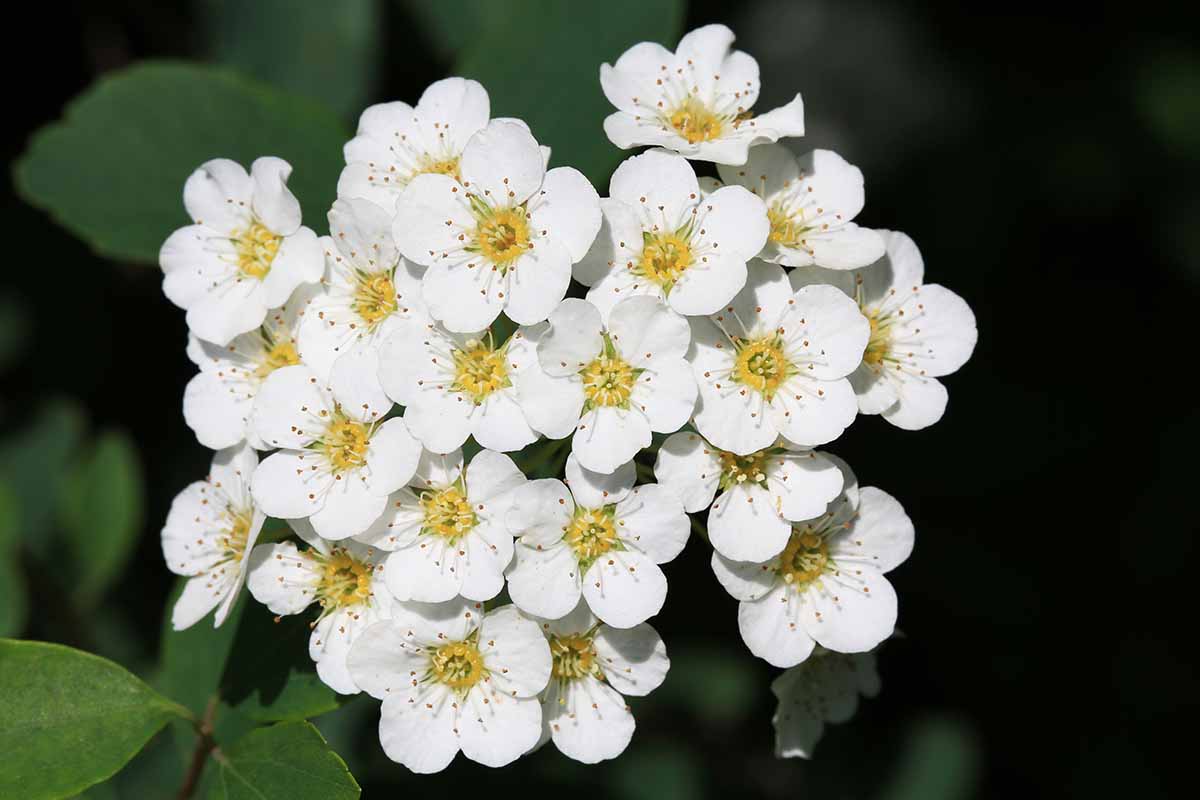
Are you already growing birchleaf spirea, or might you have a question about its growth and care that hasn’t been covered in this guide? Whether you need growing advice or want to share an experience, we welcome your input in the comments section below.
To expand your knowledge of this genus of tough but beautiful flowering shrubs, read these spirea guides next:

